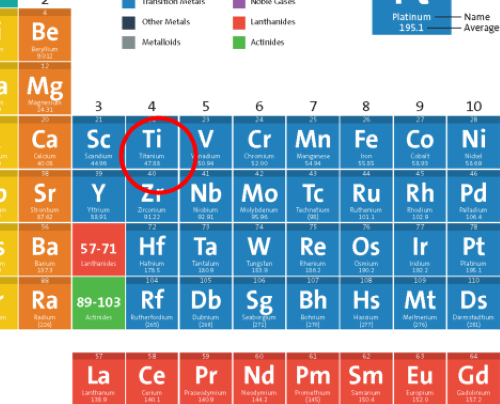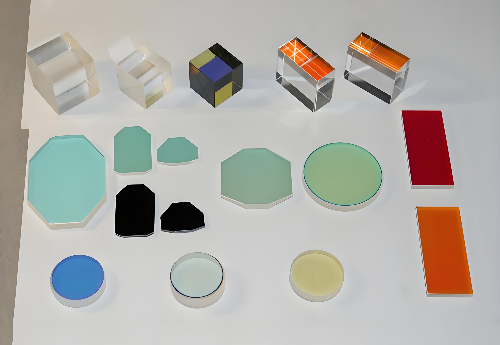ASTM Standard Specification for Titanium and Titanium Alloy Pipes

ASTM B861 Standard Specification for Titanium and Titanium Alloy Seamless Pipe
--Chemical Compositions
Products | Compositions |
UNS R50250 | Unalloyed titanium |
UNS R50400 | Unalloyed titanium |
UNS R50550 | Unalloyed titanium |
UNS R56400 | 6 % aluminum, 4 % vanadium |
UNS R52400 | 0.12 to 0.25 % palladium |
UNS R56320 | 3 % aluminum, 2.5 % vanadium |
UNS R52250 | 0.12 to 0.25 % palladium |
UNS R53400 | 0.3 % molybdenum, 0.8 % nickel |
UNS R53413 | 0.5 % nickel, 0.05 % ruthenium |
UNS R53414 | 0.5 % nickel, 0.05 % ruthenium |
UNS R53415 | 0.5 % nickel, 0.05 % ruthenium |
UNS R52402 | 0.04 to 0.08 % palladium |
UNS R52252 | 0.04 to 0.08 % palladium |
UNS R56322 | 3 % aluminum, 2.5 % vanadium, and 0.04 to 0.08 % palladium |
UNS R58640 | 3 % aluminum, 8 % vanadium, 6 % chromium, 4 % zirconium, and 4 % molybdenum |
UNS R58645 | 3 % aluminum, 8 % vanadium, 6 % chromium, 4 % zirconium, 4 % molybdenum, and 0.04 to 0.08 % palladium |
UNS R58210 | 15 % molybdenum, 3 % aluminum, 2.7 % niobium, and 0.25 % silicon |
UNS R56407 | 6 % aluminum, 4 % vanadium, extra low interstitial, ELI |
UNS R56405 | 6 % aluminum, 4 % vanadium, and 0.04 to 0.08 % palladium |
UNS R56403 | 6 % aluminum, 4 % vanadium, 0.3 to 0.8 % nickel, and 0.04 to 0.08 % palladium |
UNS R52404 | 0.08 to 0.14 % ruthenium |
UNS R52254 | 0.08 to 0.14 % ruthenium |
UNS R56323 | 3 % aluminum, 2.5 % vanadium, and 0.08 to 0.14 % ruthenium |
UNS R56404 | 6 % aluminum, 4 % vanadium, extra low interstitial, ELI, and 0.08 to 0.14 % ruthenium |
UNS R53442 | 0.4 % nickel, 0.015 % palladium, 0.025 % ruthenium, and 0.15 % chromium |
UNS R53445 | 0.4 % nickel, 0.015 % palladium, 0.025 % ruthenium, and 0.15 % chromium |
UNS R56340 | 4.5 % aluminum, 2 % molybdenum, 1.6 % vanadium, 0.5 % iron, and 0.3 % silicon |
UNS R58450 | 45 % niobium |
UNS R52815 | 1.5 % aluminum |
UNS R54250 | 4 % aluminum, 2.5 % vanadium, and 1.5 % iron |
--Dimensions Tolerance
Nominal Outside Diameter (NPS) | Permissible Variations in Outside Diameter | |
Over | Under | |
1⁄8 in. to 11⁄2 in. 3.2 mm to 38 mm | 1⁄64 in. 0.397 mm | 1⁄32 in. 0.794 mm |
over 11⁄2 in. to 4 in. 38 mm to 102 mm | 1⁄32 in. 0.794 mm | 1⁄32 in. 0.794 mm |
over 4 in. to 8 in. 102 mm to 203 mm | 1⁄16 in. 1.588 mm | 1⁄32 in. 0.794 mm |
over 8 in. to 18 in. 203 mm to 432 mm | 3⁄32 in. 2.382 mm | 1⁄32 in. 0.794 mm |
ASTM B862 Standard Specification for Titanium and Titanium Alloy Welded Pipe
--Chemical Compositions
Products | Compositions |
UNS R50250 | Unalloyed titanium |
UNS R50400 | Unalloyed titanium |
UNS R50550 | Unalloyed titanium |
UNS R56400 | 6 % aluminum, 4 % vanadium |
UNS R52400 | 0.12 to 0.25 % palladium |
UNS R56320 | 3 % aluminum, 2.5 % vanadium |
UNS R52250 | 0.12 to 0.25 % palladium |
UNS R53400 | 0.3 % molybdenum, 0.8 % nickel |
UNS R53413 | 0.5 % nickel, 0.05 % ruthenium |
UNS R53414 | 0.5 % nickel, 0.05 % ruthenium |
UNS R53415 | 0.5 % nickel, 0.05 % ruthenium |
UNS R52402 | 0.04 to 0.08 % palladium |
UNS R52252 | 0.04 to 0.08 % palladium |
UNS R56322 | 3 % aluminum, 2.5 % vanadium, and 0.04 to 0.08 % palladium |
UNS R58640 | 3 % aluminum, 8 % vanadium, 6 % chromium, 4 % zirconium, and 4 % molybdenum |
UNS R58645 | 3 % aluminum, 8 % vanadium, 6 % chromium, 4 % zirconium, 4 % molybdenum, and 0.04 to 0.08 % palladium |
UNS R58210 | 15 % molybdenum, 3 % aluminum, 2.7 % niobium, and 0.25 % silicon |
UNS R56407. Titanium alloy | 6 % aluminum, 4 % vanadium, extra low interstitial, ELI |
UNS R56405. Titanium alloy | 6 % aluminum, 4 % vanadium, and 0.04 to 0.08 % palladium |
UNS R56403 | 6 % aluminum, 4 % vanadium, 0.3 to 0.8 % nickel, and 0.04 to 0.08 % palladium |
UNS R52404 | 0.08 to 0.14 % ruthenium |
UNS R52254 | 0.08 to 0.14 % ruthenium |
UNS R56323 | 3 % aluminum, 2.5 % vanadium, and 0.08 to 0.14 % ruthenium |
UNS R56404 | 6 % aluminum, 4 % vanadium with extra low interstitial elements (ELI), and 0.08 to 0.14 % ruthenium |
UNS R53442 | 0.4 % nickel, 0.015 % palladium, 0.025 % ruthenium, and 0.15 % chromium |
UNS R53445 | 0.4 % nickel, 0.015 % palladium, 0.025 % ruthenium, and 0.15 % chromium |
UNS R56340 | 4.5 % aluminum, 2 % molybdenum, 1.6 % vanadium, 0.5 % iron, and 0.3 % silicon |
UNS R52815 | 1.5 % aluminum |
UNS R54250 | 4 % aluminum, 2.5 % vanadium, and 1.5 % iron |
UNS R53390 | 0.25 % iron, 0.4 % silicon |
--Dimensions Tolerance
Nominal Outside Diameter (NPS) | Permissible Variations in Outside Diameter | |
Over | Under | |
1⁄8 in. to 11⁄2 in. 3.2 mm to 38 mm | 1⁄64 in. 0.397 mm | 1⁄32 in. 0.794 mm |
over 11⁄2 in. to 4 in. 38 mm to 102 mm | 1⁄32 in. 0.794 mm | 1⁄32 in. 0.794 mm |
over 4 in. to 8 in. 102 mm to 203 mm | 1⁄16 in. 1.588 mm | 1⁄32 in. 0.794 mm |
over 8 in. to 18 in. 203 mm to 432 mm | 3⁄32 in. 2.382 mm | 1⁄32 in. 0.794 mm |
over 18 in. to 26 in. 432 mm to 660 mm | 1⁄8 in. 3.175 mm | 1⁄32 in. 0.794 mm |
over 26 in. to 30 in. 660 mm to 762 mm | 5⁄32 in. 3.969 mm | 1⁄32 in. 0.794 mm |
ASTM Standard Specification for Titanium and Titanium Alloy Pipes: FAQs
1. What Is the ASTM Standard for Titanium and Titanium Alloy Pipes?
The ASTM standard for titanium and titanium alloy pipes is ASTM B861 for seamless pipes and ASTM B862 for welded pipes. These standards specify the requirements for seamless and welded titanium and titanium alloy pipes intended for general corrosion-resisting and elevated-temperature services.
2. What Grades of Titanium Are Covered by the ASTM Standard?
The ASTM standards cover a range of titanium grades, each with specific chemical compositions and mechanical properties suited for different applications. Common grades include Grade 1 (unalloyed titanium), Grade 2 (unalloyed titanium), Grade 5 (Ti-6Al-4V), and Grade 9 (Ti-3Al-2.5V), among others. Each grade has distinct characteristics that make it suitable for specific environmental conditions and mechanical requirements.
3. How Are Titanium Pipes Manufactured according to the ASTM Standard?
Titanium pipes can be manufactured using several processes, depending on the specific ASTM standard. For seamless pipes (ASTM B861), the manufacturing process involves extrusion or rotary piercing techniques followed by cold working and annealing. For welded pipes (ASTM B862), the process includes forming the pipe from a sheet or plate, followed by welding using an inert gas shielded-arc welding process, and then annealing to relieve stresses and achieve the desired mechanical properties.
4. What Testing and Inspection Are Required?
The ASTM standards for titanium pipes require several tests and inspections to ensure compliance with the specified mechanical properties and quality. These may include tension tests, hydrostatic or pneumatic tests, flattening tests, and, for welded pipes, non-destructive tests such as ultrasonic or radiographic inspections. Chemical analysis is also performed to verify the material composition.
5. How Are Pipe Size and Wall Thickness Specified?
Pipe size and wall thickness for titanium pipes are specified according to the ASTM standards and are typically based on the American National Standards Institute (ANSI) pipe schedules. The standards provide detailed dimensions for nominal pipe sizes (NPS) and schedule numbers that correspond to specific wall thicknesses.
6. Can Titanium Pipes Be Used in High-Temperature Applications?
Yes, titanium and its alloys are known for their excellent strength-to-weight ratio and corrosion resistance, even at elevated temperatures. However, the maximum service temperature depends on the specific titanium grade, as each has different mechanical properties and resistance to oxidation. Generally, titanium pipes can be used in applications with temperatures up to 600°F (316°C), with some alloys capable of higher temperatures.
7. What Are the Main Applications of ASTM-Specified Titanium Pipes?
Titanium pipes specified by ASTM standards are widely used in industries where high strength, low weight, and exceptional corrosion resistance are required. These applications include aerospace hydraulic systems, chemical processing plants, power generation, desalination plants, and offshore drilling rigs. Titanium's biocompatibility also makes it suitable for medical devices and implants.


